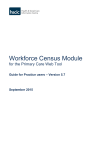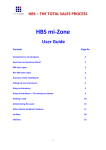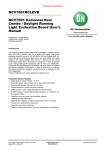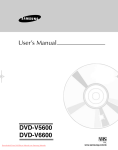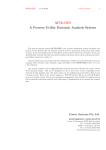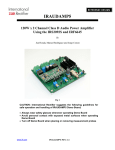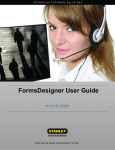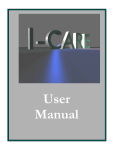Download - e
Transcript
Operate a private automatic branch exchange (PABX) switchboard D1.HFO.CL2.08 Trainer Guide Operate a private automatic branch exchange (PABX) switchboard D1.HFO.CL2.08 Trainer Guide Project Base William Angliss Institute of TAFE 555 La Trobe Street Melbourne 3000 Victoria Telephone: (03) 9606 2111 Facsimile: (03) 9670 1330 Acknowledgements Project Director: Chief Writer: Subject Writer: Project Manager: Editor: DTP/Production: Wayne Crosbie Alan Hickman Linda Wilson Alan Maguire Jim Irwin Daniel Chee, Mai Vu The Association of Southeast Asian Nations (ASEAN) was established on 8 August 1967. The Member States of the Association are Brunei Darussalam, Cambodia, Indonesia, Lao PDR, Malaysia, Myanmar, Philippines, Singapore, Thailand and Viet Nam. The ASEAN Secretariat is based in Jakarta, Indonesia. General Information on ASEAN appears online at the ASEAN Website: www.asean.org. All text is produced by William Angliss Institute of TAFE for the ASEAN Project on “Toolbox Development for Front Office, Food and Beverage Services and Food Production Divisions”. This publication is supported by Australian Aid through the ASEAN-Australia Development Cooperation Program Phase II (AADCP II). Copyright: Association of Southeast Asian Nations (ASEAN) 2013. All rights reserved. Disclaimer Every effort has been made to ensure that this publication is free from errors or omissions. However, you should conduct your own enquiries and seek professional advice before relying on any fact, statement or matter contained in this book. ASEAN Secretariat and William Angliss Institute of TAFE are not responsible for any injury, loss or damage as a result of material included or omitted from this course. Information in this module is current at the time of publication. Time of publication is indicated in the date stamp at the bottom of each page. Some images appearing in this resource have been purchased from various stock photography suppliers and other third party copyright owners and as such are non-transferable and non-exclusive. Additional images have been sourced from Flickr and are used under: http://creativecommons.org/licenses/by/2.0/deed.en http://www.sxc.hu/ http://www.stockfreeimages.com File name: TG_Operate_a_PABX_switchboard_Final Table of contents Competency Based Training (CBT) and assessment - An introduction for trainers ........... 1 Competency standard ..................................................................................................... 11 Notes and PowerPoint slides .......................................................................................... 21 Recommended training equipment ................................................................................. 63 Instructions for Trainers for using PowerPoint – Presenter View ..................................... 65 Appendix – ASEAN acronyms ........................................................................................ 67 © ASEAN 2013 Trainer Guide Operate a private automatic branch exchange (PABX) switchboard © ASEAN 2013 Trainer Guide Operate a private automatic branch exchange (PABX) switchboard Competency Based Training (CBT) and assessment – An introduction for trainers Competency Based Training (CBT) and assessment - An introduction for trainers Competency Competency refers to the ability to perform particular tasks and duties to the standard of performance expected in the workplace. Competency requires the application of specified knowledge, skills and attitudes relevant to effective participation, consistently over time and in the workplace environment. The essential skills and knowledge are either identified separately or combined. Knowledge identifies what a person needs to know to perform the work in an informed and effective manner. Skills describe the application of knowledge to situations where understanding is converted into a workplace outcome. Attitude describes the founding reasons behind the need for certain knowledge or why skills are performed in a specified manner. Competency covers all aspects of workplace performance and involves: Performing individual tasks Managing a range of different tasks Responding to contingencies or breakdowns Dealing with the responsibilities of the workplace Working with others. Unit of Competency Like with any training qualification or program, a range of subject topics are identified that focus on the ability in a certain work area, responsibility or function. Each manual focuses on a specific unit of competency that applies in the hospitality workplace. In this manual a unit of competency is identified as a „unit‟. Each unit of competency identifies a discrete workplace requirement and includes: Knowledge and skills that underpin competency Language, literacy and numeracy Occupational health and safety requirements. Each unit of competency must be adhered to in training and assessment to ensure consistency of outcomes. © ASEAN 2013 Trainer Guide Operate a private automatic branch exchange (PABX) switchboard 1 Competency Based Training (CBT) and assessment – An introduction for trainers Element of Competency An element of competency describes the essential outcomes within a unit of competency. The elements of competency are the basic building blocks of the unit of competency. They describe in terms of outcomes the significant functions and tasks that make up the competency. In this manual elements of competency are identified as an „element‟. Performance criteria Performance criteria indicate the standard of performance that is required to demonstrate achievement within an element of competency. The standards reflect identified industry skill needs. Performance criteria will be made up of certain specified skills, knowledge and attitudes. Learning For the purpose of this manual learning incorporates two key activities: Training Assessment. Both of these activities will be discussed in detail in this introduction. Today training and assessment can be delivered in a variety of ways. It may be provided to participants: On-the-job – in the workplace Off-the-job – at an educational institution or dedicated training environment As a combination of these two options. No longer is it necessary for learners to be absent from the workplace for long periods of time in order to obtain recognised and accredited qualifications. Learning Approaches This manual will identify two avenues to facilitate learning: Competency Based Training (CBT) This is the strategy of developing a participant‟s competency. Educational institutions utilise a range of training strategies to ensure that participants are able to gain the knowledge and skills required for successful: Completion of the training program or qualification Implementation in the workplace. The strategies selected should be chosen based on suitability and the learning styles of participants. 2 © ASEAN 2013 Trainer Guide Operate a private automatic branch exchange (PABX) switchboard Competency Based Training (CBT) and assessment – An introduction for trainers Competency Based Assessment (CBA) This is the strategy of assessing competency of a participant. Educational institutions utilise a range of assessment strategies to ensure that participants are assessed in a manner that demonstrates validity, fairness, reliability, flexibility and fairness of assessment processes. Flexibility in Learning It is important to note that flexibility in training and assessment strategies is required to meet the needs of participants who may have learning difficulties. The strategies used will vary, taking into account the needs of individual participants with learning difficulties. However they will be applied in a manner which does not discriminate against the participant or the participant body as a whole. Catering for Participant Diversity Participants have diverse backgrounds, needs and interests. When planning training and assessment activities to cater for individual differences, trainers and assessors should: Consider individuals‟ experiences, learning styles and interests Develop questions and activities that are aimed at different levels of ability Modify the expectations for some participants Provide opportunities for a variety of forms of participation, such as individual, pair and small group activities Assess participants based on individual progress and outcomes. The diversity among participants also provides a good reason for building up a learning community in which participants support each other‟s learning. Participant Centred Learning This involves taking into account structuring training and assessment that: Builds on strengths – Training environments need to demonstrate the many positive features of local participants (such as the attribution of academic success to effort, and the social nature of achievement motivation) and of their trainers (such as a strong emphasis on subject disciplines and moral responsibility). These strengths and uniqueness of local participants and trainers should be acknowledged and treasured Acknowledges prior knowledge and experience – The learning activities should be planned with participants‟ prior knowledge and experience in mind Understands learning objectives – Each learning activity should have clear learning objectives and participants should be informed of them at the outset. Trainers should also be clear about the purpose of assignments and explain their significance to participants Teaches for understanding – The pedagogies chosen should aim at enabling participants to act and think flexibly with what they know Teaches for independent learning – Generic skills and reflection should be nurtured through learning activities in appropriate contexts of the curriculum. Participants should be encouraged to take responsibility for their own learning Enhances motivation – Learning is most effective when participants are motivated. Various strategies should be used to arouse the interest of participants © ASEAN 2013 Trainer Guide Operate a private automatic branch exchange (PABX) switchboard 3 Competency Based Training (CBT) and assessment – An introduction for trainers Makes effective use of resources – A variety of teaching resources can be employed as tools for learning Maximises engagement – In conducting learning activities, it is important for the minds of participants to be actively engaged Aligns assessment with learning and teaching – Feedback and assessment should be an integral part of learning and teaching Caters for learner diversity – Trainers should be aware that participants have different characteristics and strengths and try to nurture these rather than impose a standard set of expectations. Active Learning The goal of nurturing independent learning in participants does not imply that they always have to work in isolation or solely in a classroom. On the contrary, the construction of knowledge in tourism and hospitality studies can often best be carried out in collaboration with others in the field. Sharing experiences, insights and views on issues of common concern, and working together to collect information through conducting investigative studies in the field (active learning) can contribute a lot to their eventual success. Active learning has an important part to play in fostering a sense of community in the class. First, to operate successfully, a learning community requires an ethos of acceptance and a sense of trust among participants, and between them and their trainers. Trainers can help to foster acceptance and trust through encouragement and personal example, and by allowing participants to take risks as they explore and articulate their views, however immature these may appear to be. Participants also come to realise that their classmates (and their trainers) are partners in learning and solving. Trainers can also encourage cooperative learning by designing appropriate group learning tasks, which include, for example, collecting background information, conducting small-scale surveys, or producing media presentations on certain issues and themes. Participants need to be reminded that, while they should work towards successful completion of the field tasks, developing positive peer relationships in the process is an important objective of all group work. Competency Based Training (CBT) Principle of Competency Based Training Competency based training is aimed at developing the knowledge, skills and attitudes of participants, through a variety of training tools. Training Strategies The aims of this curriculum are to enable participants to: Undertake a variety of subject courses that are relevant to industry in the current environment Learn current industry skills, information and trends relevant to industry Learn through a range of practical and theoretical approaches Be able to identify, explore and solve issues in a productive manner 4 © ASEAN 2013 Trainer Guide Operate a private automatic branch exchange (PABX) switchboard Competency Based Training (CBT) and assessment – An introduction for trainers Be able to become confident, equipped and flexible managers of the future Be „job ready‟ and a valuable employee in the industry upon graduation of any qualification level. To ensure participants are able to gain the knowledge and skills required to meet competency in each unit of competency in the qualification, a range of training delivery modes are used. Types of Training In choosing learning and teaching strategies, trainers should take into account the practical, complex and multi-disciplinary nature of the subject area, as well as their participant‟s prior knowledge, learning styles and abilities. Training outcomes can be attained by utilising one or more delivery methods: Lecture/Tutorial This is a common method of training involving transfer of information from the trainer to the participants. It is an effective approach to introduce new concepts or information to the learners and also to build upon the existing knowledge. The listener is expected to reflect on the subject and seek clarifications on the doubts. Demonstration Demonstration is a very effective training method that involves a trainer showing a participant how to perform a task or activity. Through a visual demonstration, trainers may also explain reasoning behind certain actions or provide supplementary information to help facilitate understanding. Group Discussions Brainstorming in which all the members in a group express their ideas, views and opinions on a given topic, is a free flow and exchange of knowledge among the participants and the trainer. The discussion is carried out by the group on the basis of their own experience, perceptions and values. This will facilitate acquiring new knowledge. When everybody is expected to participate in the group discussion, even the introverted persons will also get stimulated and try to articulate their feelings. The ideas that emerge in the discussions should be noted down and presentations are to be made by the groups. Sometimes consensus needs to be arrived at on a given topic. Group discussions are to be held under the moderation of a leader guided by the trainer. Group discussion technique triggers thinking process, encourages interactions and enhances communication skills. Role Play This is a common and very effective method of bringing into the classroom real life situations, which may not otherwise be possible. Participants are made to enact a particular role so as to give a real feel of the roles they may be called upon to play. This enables participants to understand the behaviour of others as well as their own emotions and feelings. The instructor must brief the role players on what is expected of them. The role player may either be given a ready-made script, which they can memorise and enact, or they may be required to develop their own scripts around a given situation. This technique is extremely useful in understanding creative selling techniques and human relations. It can be entertaining and energising and it helps the reserved and less literate to express their feelings. © ASEAN 2013 Trainer Guide Operate a private automatic branch exchange (PABX) switchboard 5 Competency Based Training (CBT) and assessment – An introduction for trainers Simulation Games When trainees need to become aware of something that they have not been conscious of, simulations can be a useful mechanism. Simulation games are a method based on "here and now" experience shared by all the participants. The games focus on the participation of the trainees and their willingness to share their ideas with others. A "near real life" situation is created providing an opportunity to which they apply themselves by adopting certain behaviour. They then experience the impact of their behaviour on the situation. It is carried out to generate responses and reactions based on the real feelings of the participants, which are subsequently analysed by the trainer. While use of simulation games can result in very effective learning, it needs considerable trainer competence to analyse the situations. Individual /Group Exercises Exercises are often introduced to find out how much the participant has assimilated. This method involves imparting instructions to participants on a particular subject through use of written exercises. In the group exercises, the entire class is divided into small groups, and members are asked to collaborate to arrive at a consensus or solution to a problem. Case Study This is a training method that enables the trainer and the participant to experience a real life situation. It may be on account of events in the past or situations in the present, in which there may be one or more problems to be solved and decisions to be taken. The basic objective of a case study is to help participants diagnose, analyse and/or solve a particular problem and to make them internalise the critical inputs delivered in the training. Questions are generally given at the end of the case study to direct the participants and to stimulate their thinking towards possible solutions. Studies may be presented in written or verbal form. Field Visit This involves a carefully planned visit or tour to a place of learning or interest. The idea is to give first-hand knowledge by personal observation of field situations, and to relate theory with practice. The emphasis is on observing, exploring, asking questions and understanding. The trainer should remember to brief the participants about what they should observe and about the customs and norms that need to be respected. Group Presentation The participants are asked to work in groups and produce the results and findings of their group work to the members of another sub-group. By this method participants get a good picture of each other's views and perceptions on the topic and they are able to compare them with their own point of view. The pooling and sharing of findings enriches the discussion and learning process. Practice Sessions This method is of paramount importance for skills training. Participants are provided with an opportunity to practice in a controlled situation what they have learnt. It could be real life or through a make-believe situation. 6 © ASEAN 2013 Trainer Guide Operate a private automatic branch exchange (PABX) switchboard Competency Based Training (CBT) and assessment – An introduction for trainers Games This is a group process and includes those methods that involve usually fun-based activity, aimed at conveying feelings and experiences, which are everyday in nature, and applying them within the game being played. A game has set rules and regulations, and may or may not include a competitive element. After the game is played, it is essential that the participants be debriefed and their lessons and experiences consolidated by the trainer. Research Trainers may require learners to undertake research activities, including online research, to gather information or further understanding about a specific subject area. Competency Based Assessment (CBA) Principle of Competency Based Assessment Competency based assessment is aimed at compiling a list of evidence that shows that a person is competent in a particular unit of competency. Competencies are gained through a multitude of ways including: Training and development programs Formal education Life experience Apprenticeships On-the-job experience Self-help programs. All of these together contribute to job competence in a person. Ultimately, assessors and participants work together, through the „collection of evidence‟ in determining overall competence. This evidence can be collected: Using different formats Using different people Collected over a period of time. The assessor, who is ideally someone with considerable experience in the area being assessed, reviews the evidence and verifies the person as being competent or not. Flexibility in Assessment Whilst allocated assessment tools have been identified for this subject, all attempts are made to determine competency and suitable alternate assessment tools may be used, according to the requirements of the participant. The assessment needs to be equitable for all participants, taking into account their cultural and linguistic needs. © ASEAN 2013 Trainer Guide Operate a private automatic branch exchange (PABX) switchboard 7 Competency Based Training (CBT) and assessment – An introduction for trainers Competency must be proven regardless of: Language Delivery Method Assessment Method. Assessment Objectives The assessment tools used for subjects are designed to determine competency against the „elements of competency‟ and their associated „performance criteria‟. The assessment tools are used to identify sufficient: a) Knowledge, including underpinning knowledge b) Skills c) Attitudes Assessment tools are activities that trainees are required to undertake to prove participant competency in this subject. All assessments must be completed satisfactorily for participants to obtain competence in this subject. There are no exceptions to this requirement, however, it is possible that in some cases several assessment items may be combined and assessed together. Types of Assessment Allocated Assessment Tools There are a number of assessment tools that are used to determine competency in this subject: Work projects Written questions Oral questions Third Party Report Observation Checklist. Instructions on how assessors should conduct these assessment methods are explained in the Assessment Manuals. Alternative Assessment Tools Whilst this subject has identified assessment tools, as indicated above, this does not restrict the assessor from using different assessment methods to measure the competency of a participant. Evidence is simply proof that the assessor gathers to show participants can actually do what they are required to do. Whilst there is a distinct requirement for participants to demonstrate competency, there are many and diverse sources of evidence available to the assessor. Ongoing performance at work, as verified by a supervisor or physical evidence, can count towards assessment. Additionally, the assessor can talk to customers or work colleagues to gather evidence about performance. 8 © ASEAN 2013 Trainer Guide Operate a private automatic branch exchange (PABX) switchboard Competency Based Training (CBT) and assessment – An introduction for trainers A range of assessment methods to assess competency include: Practical demonstrations Practical demonstrations in simulated work conditions Problem solving Portfolios of evidence Critical incident reports Journals Oral presentations Interviews Videos Visuals: slides, audio tapes Case studies Log books Projects Role plays Group projects Group discussions Examinations. Recognition of Prior Learning Recognition of Prior Learning is the process that gives current industry professionals who do not have a formal qualification, the opportunity to benchmark their extensive skills and experience against the standards set out in each unit of competency/subject. Also known as a Skills Recognition Audit (SRA), this process is a learning and assessment pathway which encompasses: Recognition of Current Competencies (RCC) Skills auditing Gap analysis and training Credit transfer. Assessing competency As mentioned, assessment is the process of identifying a participant‟s current knowledge, skills and attitudes sets against all elements of competency within a unit of competency. Traditionally in education, grades or marks were given to participants, dependent on how many questions the participant successfully answered in an assessment tool. Competency based assessment does not award grades, but simply identifies if the participant has the knowledge, skills and attitudes to undertake the required task to the specified standard. © ASEAN 2013 Trainer Guide Operate a private automatic branch exchange (PABX) switchboard 9 Competency Based Training (CBT) and assessment – An introduction for trainers Therefore, when assessing competency, an assessor has two possible results that can be awarded: Pass Competent (PC) Not Yet Competent (NYC) Pass Competent (PC). If the participant is able to successfully answer or demonstrate what is required, to the expected standards of the performance criteria, they will be deemed as „Pass Competent‟ (PC). The assessor will award a „Pass Competent‟ (PC) if they feel the participant has the necessary knowledge, skills and attitudes in all assessment tasks for a unit. Not Yet Competent’ (NYC) If the participant is unable to answer or demonstrate competency to the desired standard, they will be deemed to be „Not Yet Competent‟ (NYC). This does not mean the participant will need to complete all the assessment tasks again. The focus will be on the specific assessment tasks that were not performed to the expected standards. The participant may be required to: a) Undertake further training or instruction b) Undertake the assessment task again until they are deemed to be „Pass Competent‟. 10 © ASEAN 2013 Trainer Guide Operate a private automatic branch exchange (PABX) switchboard Competency standard Competency standard UNIT TITLE: OPERATE A PRIVATE AUTOMATIC BRANCH EXCHANGE (PABX) SWITCHBOARD NOMINAL HOURS: 25 UNIT NUMBER: D1.HFO.CL2.08 UNIT DESCRIPTOR: This unit deals with skills and knowledge required to operate a Private Automatic Branch Exchange (PABX) switchboard and addresses basic programming requirements ELEMENTS AND PERFORMANCE CRITERIA UNIT VARIABLE AND ASSESSMENT GUIDE Element 1: Define the PABX system and features Unit Variables 1.1 Name the PABX system in use 1.2 Describe the devices connected to the system The Unit Variables provide advice to interpret the scope and context of this unit of competence, allowing for differences between enterprises and workplaces. It relates to the unit as a whole and facilitates holistic assessment. 1.3 Identify the functions of the system keys and lights This unit applies to all industry sectors that use, or plan to introduce, a PABX switchboard into their organisation within the labour divisions of the hotel and travel industries and may include: 1.4 Identify the command structure for the system 1. Front Office Element 2: Demonstrate operational features of the system Note: there are many manufacturers of PABX switchboards and many variations in terms of models, sizes and available functions and facilities. The operation of each system is potentially different and unique to each system requiring reference to the manufacturer‟s instructions, such as operator‟s manual, user manual and system administrator‟s manual in all instances. 2.1 Write text 2.2 Create a password 2.3 Handle directory numbers 2.4 Handle category lists 2.5 Allocate programmable keys and numbers Name the PABX system may include: Identifying the manufacturer Identifying the type, model and capacity of the system Obtaining a copy of the manufacturer‟s instructions. 2.6 Allocate functions to programmable keys 2.7 Record telephone conversation © ASEAN 2013 Trainer Guide Operate a private automatic branch exchange (PABX) switchboard 11 Competency standard 2.8 Program call forwarding functions 2.9 Store commonly called numbers 2.10 Demonstrate call metering functions 2.11 Demonstrate internal message functions 2.12 Demonstrate mailbox system functions 2.13 Set date and time 2.14 Demonstrate use of special system features Element 3: Process telephone calls 3.1 Demonstrate placing an out-going call 3.2 Demonstrate receiving an in-coming call Devices connected to the system may include: Telephone handsets, including variations in use, as applicable, for reception/operator, offices, guest rooms and departments Accessories, where fitted, including tape recorder, extra bell, busy indicator outside door, Universal Serial Bus (USB) connector, extra handset, Personal Computer (PC) card, headset and conference unit. System keys and lights may include: Keys, including clear, headset, loudspeaker, mute, programmable function keys, volume, alphanumeric keys, star, hash Lights, including busy, call waiting, message, hold, incoming call, active. Command structure will vary between models/systems and refers to types of commands which may relate to: Extensions, trunks, system facilities, trunk answering position, trunk link signal, operating, maintenance, hotel and paging, extension parameters, programmable keys, mailboxes, number analysis, internal and external numbers, facility access, loudspeaker paging, group-related data, common data, voice answer, operator functions, message and information data, voice announcement recording, password definition, authority levels, control of directory numbers, show number plan, date and time, administration data, reminder, pager receiver, call metering, message group parameters and guest extension Hotel, including room status change, room-to-room bar, room-to-room open, hotel answering position, wake up options and guest instrument keys. Write text may relate to: Following manufacturer‟s instructions Confirming a system value, including entering yes/no to available system options Adding names to extensions Creating and changing passwords. 12 © ASEAN 2013 Trainer Guide Operate a private automatic branch exchange (PABX) switchboard Competency standard Create a password may relate to: Following manufacturer‟s instructions Generating a password to move from the system default setting(s) Altering passwords in accordance with internal security requirements Reading out cost counters for nominated directory numbers. Handle directory numbers may relate to: Following manufacturer‟s instructions Assigning numbers to extensions and external lines Assigning a facility group number Assigning names Storing directory numbers Assigning numbers to trunks Reading directory numbers Listing directory numbers Changing positions of extension numbers. Handle category lists may relate to: Following manufacturer‟s instructions Grouping similar user types, such as departments and classifications of staff Allocating prescribed functions and facilities Allocating extensions and trunks. Allocate programmable keys and numbers may relate to: Following manufacturer‟s instructions Re-allocating the number of programmable keys following installation of a new telephone or key panel Assigning individual abbreviated numbers Using allocation tables for number of programmable keys and individual abbreviated numbers. © ASEAN 2013 Trainer Guide Operate a private automatic branch exchange (PABX) switchboard 13 Competency standard Allocate functions to programmable keys may relate to: Following manufacturer‟s instructions Name selection function External line function Supervisor function Loudspeaker paging function Immediate answer function Enter key function Account number function Number secrecy function Caller identification function. Record telephone conversation may include: Following manufacturer‟s instructions Complying with relevant host country legislation Initiating the recording function Seeking permission to record the call Playing back the conversation for later reference Erasing the recorded call. Program call forwarding functions may relate to: Following manufacturer‟s instructions Active call diversion Diversion for no reply to internal and/or external calls Diversion when line busy Programming relevant call forwarding address Enabling by-pass of call forwarding function. 14 © ASEAN 2013 Trainer Guide Operate a private automatic branch exchange (PABX) switchboard Competency standard Store commonly called numbers may include: Following manufacturer‟s instructions Identifying required numbers Determining category lists for commonly called numbers Allocating storage locations Entering and confirming correct storage and access Allocating categories for extensions. Demonstrate call metering functions may relate to: Following manufacturer‟s instructions Own cost counters Other cost counters Reading, printing and re-setting cost counters Programming required currency identifiers. Demonstrate internal message functions may include: Following manufacturer‟s instructions Controlling call-back message Making and retrieving voice messages Sending text messages Controlling internal message functions such as: send messages for others send voice messages send text messages send „call me‟ messages Applying command group functions Applying password protocols for retrieving messages. © ASEAN 2013 Trainer Guide Operate a private automatic branch exchange (PABX) switchboard 15 Competency standard Demonstrate mailbox system functions may include: Following manufacturer‟s instructions Recording mailbox messages and greetings Changing mailbox messages and greetings Accessing mailboxes Controlling extension access to mailboxes Facilitating common mailbox use. Date and time may include: Following manufacturer‟s instructions Date, including year, month and day format Day of the week Time of day, including hour, minute and second 12-hour or 24-hour clock format. Special system features may include: Following manufacturer‟s instructions Call back Break-in to call Camp-on call Reminders, including ringing time, pause time and reminder attempts Conference call. Demonstrate placing an out-going call may include: Following manufacturer‟s instructions Placing an external call personally Placing an internal call personally to an extension Placing an external call on behalf of a third party 16 © ASEAN 2013 Trainer Guide Operate a private automatic branch exchange (PABX) switchboard Competency standard Placing an internal call on behalf of a third party Transferring calls Placing a call using stored numbers Placing a call using the alpha-numeric keys Recording an out-going call Adhering to host enterprise telephone procedures. Demonstrate receiving an in-coming call may include: Following manufacturer‟s instructions Answering a call from an external caller Answering a call from an internal caller Using the system to differentiate between internal and external calls Placing calls on hold Transferring calls Adhering to host enterprise telephone procedures Recording an in-coming call. Assessment Guide The following skills and knowledge must be assessed as part of this unit: The enterprise‟s policies and procedures in regard to the operation of the telephone system, including legal and privacy issues Principles of telephone communication and techniques Knowledge of the features and facilities available as relevant to the system in use Knowledge of the legal requirements that apply to the recording and playing of telephone messages, as prescribed by the host country Knowledge of authorisation levels for use of the functions that are available. © ASEAN 2013 Trainer Guide Operate a private automatic branch exchange (PABX) switchboard 17 Competency standard Linkages To Other Units Communicate on the telephone Work effectively with colleagues and customers Maintain quality customer/guest service Work cooperatively in a general administration environment Use common business tools and technology Receive and place in-coming phone calls Facilitate out-going phone calls Provide international (IDD) service information. Critical Aspects of Assessment Evidence of the following is essential: Understanding of host enterprise policies and procedures in regard to the operation of the telephone system, including legal and privacy issues Demonstrated ability to effectively and efficiently operate a nominated PABX system to undertake designated tasks, where provided for by the system, which must include: Placing at least three out-going calls to an external number using stored number function Placing at least three out-going calls to an internal number/extension using stored number function Receiving at least three in-coming calls from external numbers Receiving at least three in-coming calls from internal numbers Transferring at least three calls to nominated extensions Placing at least three calls on hold and successfully restoring connection Recording a voice message on a reorder/mailbox Setting the date and time Adding at least three given numbers to the number storage function of the system Altering at least one password Using a headset to process at least three calls Undertaking at least five other nominated functions. 18 © ASEAN 2013 Trainer Guide Operate a private automatic branch exchange (PABX) switchboard Competency standard Context of Assessment This unit may be assessed on or off the job: Assessment should include practical demonstration either in the workplace or through a simulation activity, supported by a range of methods to assess underpinning knowledge Assessment must relate to the individual‟s work area or area of responsibility. Resource Implications Training and assessment to include access to a real or simulated workplace and PABX switchboard system; and access to workplace standards, procedures, policies, guidelines, tools and equipment. Assessment Methods The following methods may be used to assess competency for this unit: Case studies Observation of practical candidate performance Oral and written questions Role plays Third party reports completed by a supervisor Project and assignment work. Key Competencies in this Unit Level 1 = competence to undertake tasks effectively Level 2 = competence to manage tasks Level 3 = competence to use concepts for evaluating Key Competencies Level Collecting, organising and analysing information 1 Examples Capture details for entry onto the PABX system © ASEAN 2013 Trainer Guide Operate a private automatic branch exchange (PABX) switchboard 19 Competency standard 20 Communicating ideas and information 1 Advise callers regarding calls Planning and organising activities 1 Identify the sequence for answering and processing calls during busy periods Working with others and in teams 1 Liaise with other staff in relation to functions and facilities available through the system Using mathematical ideas and techniques 1 Determine cost of calls through cost counters Solving problems 1 Locate required person while placing call on hold Using technology 1 Use the PABX system at the workplace © ASEAN 2013 Trainer Guide Operate a private automatic branch exchange (PABX) switchboard Notes and PowerPoint slides Notes and PowerPoint slides Slide Slide No 1. Trainer Notes Trainer welcomes students to class. © ASEAN 2013 Trainer Guide Operate a private automatic branch exchange (PABX) switchboard 21 Notes and PowerPoint slides Slide Slide No 2. Trainer Notes Discussion of what a PABX system is – understanding the abbreviated terms. There are many manufacturers of PABX systems today throughout the world. This Private Automated Branch Exchange (PABX) is a telephone network that is commonly used by call centers and other organisations that allows for single access numbers to offer multiple lines to outside callers while providing a range of external lines to internal callers and staff. So, in such cases, installing business phone network systems is a great option. Not only does it save you time and money in the office, but also prevents you from losing out on potential business, even when you are away. 22 © ASEAN 2013 Trainer Guide Operate a private automatic branch exchange (PABX) switchboard Notes and PowerPoint slides Slide Slide No 3. Trainer Notes Discuss with the class if they know anything about any of these systems Discuss the system brand name that the students will be using Discuss the systems they may have come across in the training manual. © ASEAN 2013 Trainer Guide Operate a private automatic branch exchange (PABX) switchboard 23 Notes and PowerPoint slides Slide Slide No 4. 24 Trainer Notes Discussion of what to look for when deciding on what PABX system is suitable. © ASEAN 2013 Trainer Guide Operate a private automatic branch exchange (PABX) switchboard Notes and PowerPoint slides Slide Slide No 5. Trainer Notes Multiple Sites: Are you planning of using this equipment on multiple sites, if so you want a system that allows for multiple sites. If you are not intending to use this function there is no point buying and paying for a system with this function if you are not intending to use it. VOIP solution – Voice over IP telephony solutions unify voice, video, data, and mobile applications on fixed and mobile networks enabling users to easily communicate in any workspace using any media, device, or operating system. Call centre functionality – enables other staff to pick up a call no matter what extension is ringing. Also allows for automatic answering that is forwarded to the next available staff member. Computer Network Integration – allows you to integrate with a network computer system – to display missed calls, access your voice box via your computer system. Opens up a whole extra range of telephone solutions using your computer network. Ability To Monitor Calls- allows the supervisor to check on new staff and assist with staff training. Self Administration For Mgt – the system does a lot of the administration work for management. Keeps track of calls made, the cost of calls, etc. Size of the establishment – refer back to the training manual for details of functions for different sized properties. © ASEAN 2013 Trainer Guide Operate a private automatic branch exchange (PABX) switchboard 25 Notes and PowerPoint slides Slide Slide No Trainer Notes 6. Discussion of devices to be added to telephone system. 26 © ASEAN 2013 Trainer Guide Operate a private automatic branch exchange (PABX) switchboard Notes and PowerPoint slides Slide Slide No 7. Trainer Notes Activity: Students to work in groups of 3 – 4 discuss the number of devices they can think of that can be added to a telephone system. It is ok to include devices for mobile phones. Discuss the findings with the class – relate this back to the devices on a PABX business system. © ASEAN 2013 Trainer Guide Operate a private automatic branch exchange (PABX) switchboard 27 Notes and PowerPoint slides Slide Slide No 8. Trainer Notes Room status system – allows the telephone system to be used to record the status of each room into the telephone system. The room attendant or supervisor dials a particular number in the room to indicate it is VC – Vacant Clean or OC – Occupied clean, even out of order rooms (rooms that cannot be sold ) can be detected via the telephone system Wake up calls – guests will request a wakeup call time – this is programmed into the telephone and a recorded messages is relayed to the guest when they wakeup. 28 Usually telling them the time and what the weather is going to be in the city for the day. © ASEAN 2013 Trainer Guide Operate a private automatic branch exchange (PABX) switchboard Notes and PowerPoint slides Slide Slide No 9. Trainer Notes Discuss the mentioned system keys as per the training manual. © ASEAN 2013 Trainer Guide Operate a private automatic branch exchange (PABX) switchboard 29 Notes and PowerPoint slides Slide Slide No 10. 30 Trainer Notes Discuss these points as per the training manual details. © ASEAN 2013 Trainer Guide Operate a private automatic branch exchange (PABX) switchboard Notes and PowerPoint slides Slide Slide No 11. Trainer Notes Identify the system keys on your telephone system – List 5 and describe their function and training instructions on how they work. Students can work in pairs if they like. © ASEAN 2013 Trainer Guide Operate a private automatic branch exchange (PABX) switchboard 31 Notes and PowerPoint slides Slide Slide No 12. Trainer Notes Abbreviated dialling Speed dialling a phone number by entering an assigned index code (1-99) on your phone key pad. Auto dial Once you start to dial a number that you have dialled before the system recognises the first few digits and displays a list of likely numbers for you to choose from. Call logs Enables you to view records of all the missed, received and placed calls. Call waiting Offers you the ability to answer an incoming call while you are on another call. Language or Local setting Enables you to change the language that is programmed into the phone. Maintenance agreement Not having a maintenance agreement can prove to be costly. It is best to have a maintenance agreement with the purchasing company that provided your PABX system to have professional ICT technicians to diagnose and repair problems with the minimum amount of downtime and not be charged a fortune in service charges. Maintenance agreements will vary according to what you pay for. 32 © ASEAN 2013 Trainer Guide Operate a private automatic branch exchange (PABX) switchboard Notes and PowerPoint slides Personal address book sync Allows synchronising data that is stored in Microsoft Windows or Microsoft outlook or Microsoft Outlook Express address books with your telephone system. Recorded voice announcement Ability to convert text messages to a voice or speech recording. Therefore, there is no need to pay for humans to record messages for you. Video support Some telephone systems will support video calls if compatible equipment such as video phone, camera and video software are available. Activity: Students Using the telephone system identify 2 Command structure features and detail instructions on how to use these commands. Share the features chosen with the rest of the class. Each student is to “teach” the class how to use one of their features. Alternatively: Teacher can allocate a command structure to each student (from the telephone system) – get them to write the instructions and each student must “teach” the class how to use their assigned command structure feature. © ASEAN 2013 Trainer Guide Operate a private automatic branch exchange (PABX) switchboard 33 Notes and PowerPoint slides Slide Slide No 13. Trainer Notes Activity: Students Using the telephone system identify 2 Command structure features and detail instructions on how to use these commands. Share the features chosen with the rest of the class. Each student is to “teach” the class how to use one of their features. Alternatively: Teacher can allocate a command structure to each student (from the telephone system) – get them to write the instructions and each student must “teach” the class how to use their assigned command structure feature. 34 © ASEAN 2013 Trainer Guide Operate a private automatic branch exchange (PABX) switchboard Notes and PowerPoint slides Slide Slide No 14. Trainer Notes When writing text you may be able to use the local language or have an option to use English for house guests Always follow the manufacturer‟s instructions May have to use the corporate directory to get extra data for your text such as telephone extension numbers, names of mangers etc. Make sure you keep the text professional – do not use TEXT abbreviations. Activity: Write or discuss a suitable text for the following. 1. Mr. Armstrong your secretary has called today at noon she wants you to return the call as it is important. She is not at the normal office instead she is at the City office. (E.g.: Call your secretary at the city office – important) 2. call Mr Wong b4 6pm 2nite he has gr8 tickets f.y. © ASEAN 2013 Trainer Guide Operate a private automatic branch exchange (PABX) switchboard 35 Notes and PowerPoint slides Slide Slide No 15. Trainer Notes Activity: Write or discuss a suitable text for the following. 1. Mr. Armstrong your secretary has called today at noon she wants you to return the call as it is important. She is not at the normal office instead she is at the City office. (e.g.: Call your secretary at the city office – important) 2. Call Mr. Wong before 6pm tonight he has great tickets to the football for you. (e.g. call Mr. Wong b4 6pm 2nite he has gr8 tickets 2 football f.y.) 36 © ASEAN 2013 Trainer Guide Operate a private automatic branch exchange (PABX) switchboard Notes and PowerPoint slides Slide Slide No 16. Trainer Notes Discuss the reasons for using passwords and its importance to security. © ASEAN 2013 Trainer Guide Operate a private automatic branch exchange (PABX) switchboard 37 Notes and PowerPoint slides Slide Slide No 17. Trainer Notes Most companies will have a listing of corporate directory numbers. This may also include all emergency service numbers and numbers that are frequently called. These directory numbers need to be maintained and updated. A staff champion will need to be assigned to this task and be fully responsible for handling directory numbers. 38 © ASEAN 2013 Trainer Guide Operate a private automatic branch exchange (PABX) switchboard Notes and PowerPoint slides Slide Slide No 18. Trainer Notes When directory numbers are created it might be necessary to develop categories rather than simply have alphabetical listings. Categories are groups that are similar, for example a list of Bars, then identify the names of the bars, or housekeeping staff then list the names of the housekeeping staff. This provides additional options when searching for numbers it can also make the process of finding a directory number faster. © ASEAN 2013 Trainer Guide Operate a private automatic branch exchange (PABX) switchboard 39 Notes and PowerPoint slides Slide Slide No 19. Trainer Notes This screen could be printed out and given to students for them to develop categories for the phone listing. Answer: Categories - Admin assistants, Bars, PA‟s and Restaurants Make sure the students have listed the categories – alphabetically Make sure the students have listed the names alphabetically within each category. 40 © ASEAN 2013 Trainer Guide Operate a private automatic branch exchange (PABX) switchboard Notes and PowerPoint slides Slide Slide No 20. Trainer Notes Discuss the use of programmable keys and numbers. © ASEAN 2013 Trainer Guide Operate a private automatic branch exchange (PABX) switchboard 41 Notes and PowerPoint slides Slide Slide No 21. Trainer Notes Name selection function enables you to find a directory name by typing or texting in only a few letters e.g.: Wil for Wilson. Automatic external line function which allows you to make external calls without having to get an outside line. Supervisor function is used when new staff are in training and the supervisor will be on the same line as the trainee to check on their telephone technique. This function can be programmed to have password access to prevent other staff using this facility. Loudspeaker Paging function provides attendants and telephone users dial access to voice paging equipment. Immediate answer function is when a programmed message is activated after one or two rings. Account number function is used as reference numbers to determine the content of certain accounts used in various reports. Number secrecy function should be programmed so that when numbers are typed or texted onto the screen they convert to a hash "#" sign of security. Caller identification function enables the telephone system to display the name or number of the caller. 42 © ASEAN 2013 Trainer Guide Operate a private automatic branch exchange (PABX) switchboard Notes and PowerPoint slides Slide Slide No 22. Trainer Notes Always follow the manufacturer's instructions on how to use the telephone recording system. It is essential to understand the legal ramifications of recording a telephone conversation. Make sure you comply with the relevant host countries legislations. Initiating the recording function maybe a simple as pushing the "record" button or more complicated in that you need to apply an adapter If a call is to be recorded or monitored, an organisation must tell the caller at the beginning of the conversation so that the caller will have the chance either to end the call, or to ask to be transferred to another line where monitoring or recording does not take place if this is available If you have recorded a call you must know how to play it back or listen to it after the call When the purpose to which you needed to record the conversation is finished then make sure you erase the recorded call. There is no need to keep out dated telephone recordings on your telephone system forever; in fact most systems will have a limited capacity for recording calls, so keep this space available for when the need arises. © ASEAN 2013 Trainer Guide Operate a private automatic branch exchange (PABX) switchboard 43 Notes and PowerPoint slides Slide Slide No 23. Trainer Notes Get the students to work in pairs to do this exercise. Have the students read out some of their scripts for telling the guest about the recording. 44 © ASEAN 2013 Trainer Guide Operate a private automatic branch exchange (PABX) switchboard Notes and PowerPoint slides Slide Slide No 24. Trainer Notes Active call diversion is when someone is trying to call you and you are already on the phone. The new caller will automatically be forwarded to your voicemail box to leave a message. However, some phone systems have a call waiting option which enables the telephonist to put the first call on hold, answer the second call, then go back to the first call again. There are times when clients or customers will ring your direct line and you are unavailable (busy) or they receive no reply. The options the callers have is to leave a message on voicemail or some telephone systems will actually forward the call to an operator who asks the caller if someone else can help them or re-directs the call to another phone number such as your mobile. Programming the call forward address usually means typing in the numbers you want the call to be diverted to either permanently, when busy or when out of the office after a certain number of rings. Enabling by-pass to call forwarding is to have the call diverted to your voicemail box to the caller to leave a message. © ASEAN 2013 Trainer Guide Operate a private automatic branch exchange (PABX) switchboard 45 Notes and PowerPoint slides Slide Slide No 25. 46 Trainer Notes Activity – Follow manufacturer‟s instructions to test the students on using call forwarding. © ASEAN 2013 Trainer Guide Operate a private automatic branch exchange (PABX) switchboard Notes and PowerPoint slides Slide Slide No 26. Trainer Notes There should be a discussion or workshop to decide what the commonly called numbers in your area are. It is important to capture numbers that relate to all situations not just one persons' opinion. It may be necessary to categorise these commonly called numbers for example, Category: Emergency Service - for police, fire, ambulance, bomb squad, or service numbers such as doctor and dentist favourite transport company, restaurants, etc. Make sure you allocate logical storage locations on your telephone system for these numbers. Staff training or communication is essential to ensure that all staff are familiar with this storage function. Entering and confirming correct access and storage must be kept up to date and maintained. © ASEAN 2013 Trainer Guide Operate a private automatic branch exchange (PABX) switchboard 47 Notes and PowerPoint slides Slide Slide No 27. Trainer Notes Call metering is the process for determining call charges for a telephone call made through your telephone system for local, national and international calls. The PABX system will meter the calls based on time and pulses. All the costs will be recorded against the number called, time of day and date. Other costs may be counted such as operator directed calls to other countries, directory assistance, reverse charges, person to person and so on. Cost counters will produce printed records, provide account totals for various extensions, and produce charges for in house guests' phone calls. Likewise, these cost counters need to be re-set after end of day processes or when a guest departs from a room. Cost counters can be available at the location of the calling telephone, a guest's room for example. A keyboard is provided through which the number to be called is entered; this number appears on a display and can be checked for accuracy before the number is actually "dialled" by depressing another key on the keyboard. At this time the initial billing rate and initial billing time period appear on digital displays, as well as the billing rate for the next billing time period and the corresponding period duration. This provides an accurate indication of the cost of the call. Call metering can be programmed to a countries currency or set in whatever currency they choose to use. 48 © ASEAN 2013 Trainer Guide Operate a private automatic branch exchange (PABX) switchboard Notes and PowerPoint slides Slide Slide No 28. Trainer Notes Internal message systems are set up by staff so there must be some parameters set to ensure these messages are professional and accurate. Call back messages can be initiated after the caller plays back their message. There is no need to dial the number; a direct connection is set up for the call back. A call back can be initiated to both internal and external callers. Follow the instructions to make voice mail messages. Make sure they are professional. It is recommended that the retrieval of voice messages requires a password to protect the messages for the actual voice mail owner and not have other staff access these messages. Call me messages are automatic messages sent asking a particular number to be called. There is no interaction with the caller, just an automatic response sent. This will need to be programmed into your system if you want to use this particular function. © ASEAN 2013 Trainer Guide Operate a private automatic branch exchange (PABX) switchboard 49 Notes and PowerPoint slides Slide Slide No 29. Trainer Notes Personal voice messages need to be clear and precise. Open with a greeting welcoming the caller, identify who has been called, explain why you are unavailable, offer an alternative contact number or ask them to leave a short message. Single voice mailbox All missed calls are stored on your internal company mailbox. Serial call Calls coming through a fixed line telephone with call forwarding to a defined alternate destination number (mobile phone, for instance). Distribution lists for voice mail A system of voice distribution lists can help you in the distribution of voice messages. Whether you forward messages or record specific voice messages, you can use the distribution list to reach your team quickly and effectively. Message broadcasting Provide information on current topics by broadcasting voice messages. As an authorised user, sending information to all of your colleagues in one fell swoop could not be easier - all you need to do is record a message or forward a received message to all mailboxes who have been added to your voice distribution list (extension numbers). 50 © ASEAN 2013 Trainer Guide Operate a private automatic branch exchange (PABX) switchboard Notes and PowerPoint slides Message Waiting Indicator When new messages are received in your mailbox, a message waiting indicator is displayed via an LED illumination: A text message in the telephone display The number of new messages is displayed Voice to e-mail. © ASEAN 2013 Trainer Guide Operate a private automatic branch exchange (PABX) switchboard 51 Notes and PowerPoint slides Slide Slide No 30. Trainer Notes Access protection All mailboxes are protected against unauthorised access by a 3- to 8-digit password. Messages can only be played back or mailboxes can only be administered after authentication. The default password assigned at initial installation must be changed the first time the mailbox is used. This can be configured by the technician and it is good practise to regularly change your password for security reasons. Group mailboxes All sales staff are busy on calls? No problem, the next caller is routed to the group mailbox and is invited to leave a message which ensures that your customer‟s query is dealt with promptly because the first free staff member can check and process the new message immediately. Routing mailboxes In addition to inviting your callers to leave a message, the routing mailbox gives callers an opportunity to reach you or your colleague directly. Welcome to the mailbox of Henry Wong. I am not at my desk right now, but if you would like to leave a message, please speak after the tone or press “1” to call my mobile phone. Press “2” for assistance from my colleague. 52 © ASEAN 2013 Trainer Guide Operate a private automatic branch exchange (PABX) switchboard Notes and PowerPoint slides Auto Attendant mailbox Use the Auto Attendant mailbox as an automatic attendant. The basic function of the automatic attendant is called “announcement before answering”. Announcement before answering begins with a company greeting. For example, “Welcome to the Majestic Hotel. Our attendants are busy right now. Please hold the line.” Backup and restore the voicemail database The database can be either partially or fully backed up. The data can be saved to an external data medium belonging to the customer and used for partial or full restoration. © ASEAN 2013 Trainer Guide Operate a private automatic branch exchange (PABX) switchboard 53 Notes and PowerPoint slides Slide Slide No 31. Trainer Notes This activity is designed to get the students to prepare and set up a voice mail message. Have the students dial each other‟s extension number so they can hear the voice mail messages. Optional – Allocate job title to the students so they can prepare their voice message accordingly. 54 © ASEAN 2013 Trainer Guide Operate a private automatic branch exchange (PABX) switchboard Notes and PowerPoint slides Slide Slide No 32. Trainer Notes Date should be entered with the day, month and year or alternatively, month, day, year format. Some establishments will also require the configuration of the day of the week as well as the date such as Wednesday 16th June. Time of the day may also incorporate the hour, minute and seconds. 12 hour or 24 hour clock system format. © ASEAN 2013 Trainer Guide Operate a private automatic branch exchange (PABX) switchboard 55 Notes and PowerPoint slides Slide Slide No 33. Trainer Notes Call back Calls to busy or unanswered extensions are automatically re-established across the network when the extension becomes free or is not used. This saves time for the staff member as you don‟t have to remember to dial the person again - the telephone system "remembers" you wanted to call this number and as soon as it is free - it rings the number for you. When a call back rings - it is a different ring to a normal call, it usually rings at a faster ring, this is to remind you of your call back. A Call Back can be initiated to bother internal or external callers. Break-in to call Having a facility to Break in to a call may be necessary for international calls restricted to a particular price or time limit - the caller is reminded that there is only one minute of this call left so they can prepare to say goodbye. Person to person calls also require the break-in facility as the telephone operator needs to break into the conversation to ascertain that the person at the other end of the line is the person who is being called, once this is established the call will be connected. Reverse charge calls is another area that the break-in facility would be used. Reverse charges is when the call is to be paid by the person receiving the call and not the caller. The telephone operator needs to get the details of the person paying for the call, break into the call to check that the receiver of the call is prepared to pay for the call then allow the call to go through to the required parties. 56 © ASEAN 2013 Trainer Guide Operate a private automatic branch exchange (PABX) switchboard Notes and PowerPoint slides Camp-on Call A telecommunication system that answers incoming calls and instead of going to voicemail or being put on hold the caller is placed in a queue and as soon as the required line clears the call is put through. This system feature permits holding an incoming telephone call until the called party is free. Reminders With Reminder service, you can arrange for the system to make reminder calls at preset times. Reminder call acts like an alarm on your phone - your phone will ring when you program it to. Maybe you need a reminder each day or a one off reminder to attend a special meeting. You can push a button to activate this service put in the date and time of day you need to be reminded. In some systems you can specify the amount of rings you need to the reminder call. Conference Call Teleconferencing can be done through an audio conference call using only the telephone or through the web if you need to share files or visual aids. Since most companies have resources for outbound conference calls via the phone, that is what we will cover here. First of all, you need to schedule the audio conference call for a time that is convenient for all parties. When you are teleconferencing with people in different geographic areas, it is key to remember that they may be in different time zones and schedule your call for a time that falls near normal working hours for all parties. Once you have your list of attendees and time you will find that it is not so much how to make a conference call but the etiquette of what you do on the call that matters. © ASEAN 2013 Trainer Guide Operate a private automatic branch exchange (PABX) switchboard 57 Notes and PowerPoint slides Slide Slide No 34. Trainer Notes When making outgoing calls on behalf of an enterprise or third party, unless the client or guest knows the numbers they need you will have to consult a directory. Establish contact over the PABX Using your PABX system place the external call personally following the instructions from the manufacturer. Once you have been connected to the number you requested or dialled the person at the other end should answer with acceptable telephone etiquette giving an appropriate greeting and give the name of the establishment. Transfer calls Make sure you know the process to put the call on hold and that you can use the transfer operational process to contact another extension without cutting off the original caller. When transferring calls it is important to transfer information to the new department as well and not let the "customer or guest" have to keep repeating themselves. Placing an internal call on behalf of a third party The difference of dialling an internal call on behalf of a third party compared to an external call is that the process is much simpler as you can use your speed dial numbers for the required extension number. You may also have more options available to you to use such as diverting to another number, using call back, or call forwarding, even voicemail. 58 © ASEAN 2013 Trainer Guide Operate a private automatic branch exchange (PABX) switchboard Notes and PowerPoint slides Place a call using stored numbers & alpha-numeric keys When placing a call using store number you simple press the required digit for the stored phone number and the call is automatically made to that phone number. You save time as you only used one keystroke instead of dialling the complete phone number on the keypad. © ASEAN 2013 Trainer Guide Operate a private automatic branch exchange (PABX) switchboard 59 Notes and PowerPoint slides Slide Slide No 35. Trainer Notes In this activity the students have to demonstrate their ability to use the telephone system to place an outgoing call. Carefully follow the procedure to make a third party call – you may have to question the students on the operation of the system – or prepare sheets with third party calls to be made. For example: Place a call for Mr. Jenkins in Room 1521 to Milan, Italy – He wants to speak to Mr. Giuseppe Imbesi the Managing Director of Fabrico Imports. Using the directory find the international dialling code for Italy and Milan – and prepare a script you would use to ask for Mr. Imbesi Describe the procedures you would use to get the call to Mr. Jenkins or demonstrate this using the telephone system. 60 © ASEAN 2013 Trainer Guide Operate a private automatic branch exchange (PABX) switchboard Notes and PowerPoint slides Slide Slide No 36. Trainer Notes Placing calls on hold As mentioned before let the caller know why you are putting them on hold and what you are doing. Don‟t forget to return to any calls on hold sometimes, you can get busy and forget you have a call on hold. Use the telephone system to 'store' the call on hold correctly. Transferring calls The skill of transferring an incoming call requires a complete understanding of the workings of the telephone equipment you are using otherwise, you are likely to cut the caller off and loose them altogether. When transferring calls it is important to transfer information to the new department as well and not let the "customer or guest" have to keep repeating themselves. Recording in- coming calls Follow the manufacturer's instructions to record in-coming calls and remember to follow the legal obligations relating to recording calls. © ASEAN 2013 Trainer Guide Operate a private automatic branch exchange (PABX) switchboard 61 Notes and PowerPoint slides Slide Slide No 37. Trainer Notes This activity is designed to check how well the students have learnt to deal with an incoming call: Check for a suitable and appropriate greeting Look for an understanding of the “on hold” key – asks questions if necessary Have student A on the telephone calling an establishment and have Student B demonstrating the use of the telephone system Teacher might have to prepare a script for the student A to use – in order to have the appropriate information for student B. 62 © ASEAN 2013 Trainer Guide Operate a private automatic branch exchange (PABX) switchboard Recommended training equipment Recommended training equipment PABX telephone system – one per student (or individual user access for each student) any brand Internet access Conference call equipment Pagers Headset & handsets Whiteboard Computers (one per student) © ASEAN 2013 Trainer Guide Operate a private automatic branch exchange (PABX) switchboard 63 Recommended training equipment 64 © ASEAN 2013 Trainer Guide Operate a private automatic branch exchange (PABX) switchboard Instructions for Trainers for using PowerPoint – Presenter View Instructions for Trainers for using PowerPoint – Presenter View Connect your laptop or computer to your projector equipment as per manufacturers‟ instructions. In PowerPoint, on the Slide Show menu, click Set up Show. Under Multiple monitors, select the Show Presenter View check box. In the Display slide show on list, click the monitor you want the slide show presentation to appear on. Source: http://office.microsoft.com Note: In Presenter View: You see your notes and have full control of the presentation Your trainees only see the slide projected on to the screen More Information You can obtain more information on how to use PowerPoint from the Microsoft Online Help Centre, available at: http://office.microsoft.com/training/training.aspx?AssetID=RC011298761033 Note Regarding Currency of URLs Please note that where references have been made to URLs in these training resources trainers will need to verify that the resource or document referred to is still current on the internet. Trainers should endeavour, where possible, to source similar alternative examples of material where it is found that either the website or the document in question is no longer available online. © ASEAN 2013 Trainer Guide Operate a private automatic branch exchange (PABX) switchboard 65 Instructions for Trainers for using PowerPoint – Presenter View 66 © ASEAN 2013 Trainer Guide Operate a private automatic branch exchange (PABX) switchboard Appendix – ASEAN acronyms Appendix – ASEAN acronyms AADCP ASEAN – Australia Development Cooperation Program. ACCSTP ASEAN Common Competency Standards for Tourism Professionals. AEC ASEAN Economic Community. AMS ASEAN Member States. ASEAN Association of Southeast Asian Nations. ASEC ASEAN Secretariat. ATM ASEAN Tourism Ministers. ATPMC ASEAN Tourism Professionals Monitoring Committee. ATPRS ASEAN Tourism Professional Registration System. ATFTMD ASEAN Task Force on Tourism Manpower Development. CATC Common ASEAN Tourism Curriculum. MRA Mutual Recognition Arrangement. MTCO Mekong Tourism Coordinating office. NTO National Tourism Organisation. NTPB National Tourism Professional Board. RQFSRS Regional Qualifications Framework and Skills Recognition System. TPCB Tourism Professional Certification Board. © ASEAN 2013 Trainer Guide Operate a private automatic branch exchange (PABX) switchboard 67 Appendix – ASEAN acronyms 68 © ASEAN 2013 Trainer Guide Operate a private automatic branch exchange (PABX) switchboard















































































